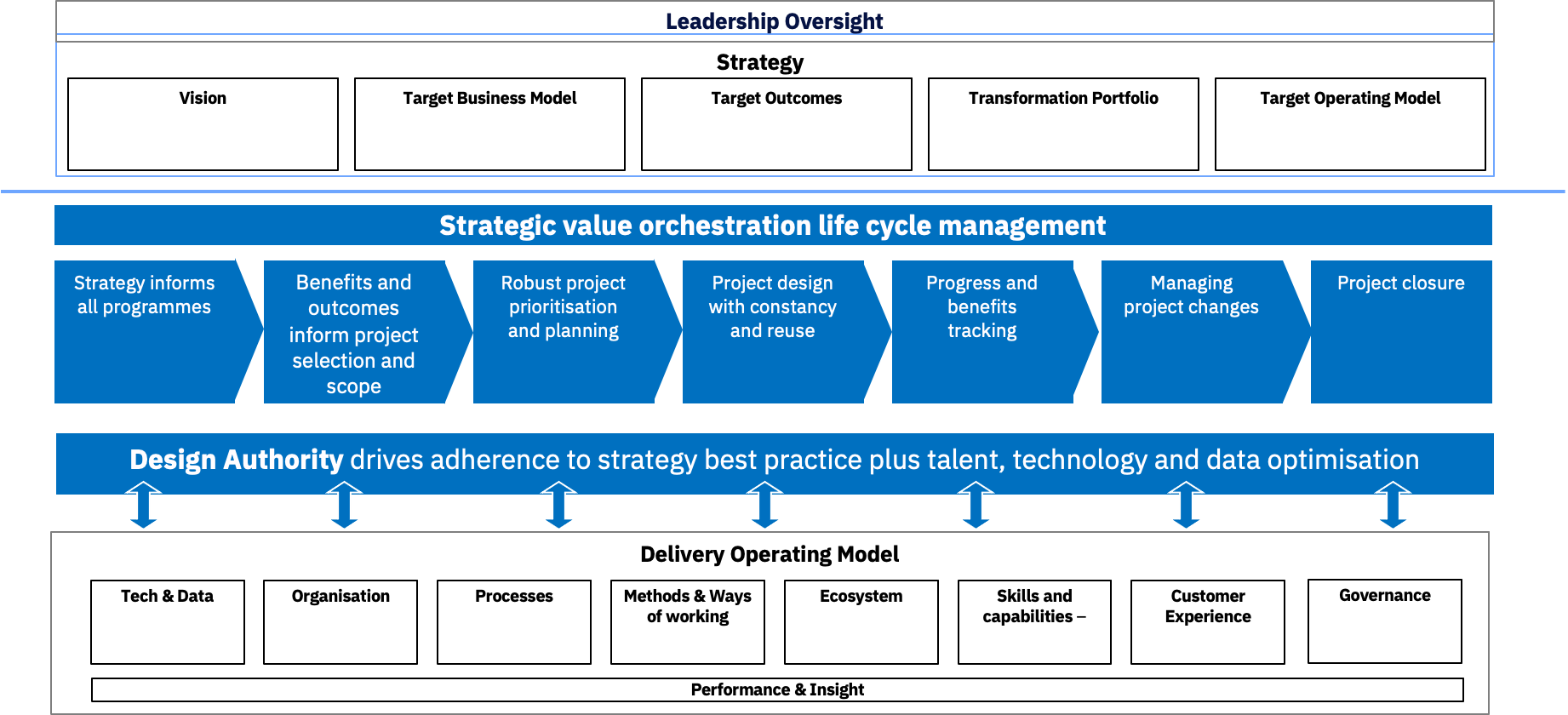Perspectives
NextGen Business Architecture, Part 1: A critical partner in strategy and design
17 December, 2021 | Written by: Christopher Dabrowski and Jon Barber
Categorized: Perspectives
Share this post:
Has Business Architecture become irrelevant?
In a digital world, where speed is of the essence and agile delivery and customer-centred design have become the default mechanisms for driving change, there is a powerful argument to be made that the Business Architect has become irrelevant and that Business Architecture now acts as a blocker, rather than an enabler, of transformational change.
We disagree. Business Architecture is an even more critical function in modern digital transformations, linking strategy to execution and playing a pivotal role in the delivery of transformational change. As guardian of the business vision, it translates strategy into a clear set of outcomes, benefits and design parameters that guide the portfolio of work delivering transformation.
But in a world increasingly characterised by dynamic user requirements, delivery at pace, financially constrained decision-making and hybrid (agile/waterfall) delivery models the discipline needs to change. If it doesn’t, Business Architecture functions will do more harm than good if they don’t evolve to meet today’s challenges.
To punch their weight in a modern digital transformation, Business Architecture functions need to be much more deeply engaged in delivery, convening Strategy, Finance, Operations, and Digital leaders to drive change. They need to curate clear guardrails linked to business outcomes that empower delivery teams to realise business value. They need to act as the orchestrator of value at the heart of a complex delivery ecosystem. They need to build the necessary consensus and common language to align the organisation around delivering meaningful change.
We call this NextGen Business Architecture, a reinvented function that drives business value through coherence and collaboration.
NextGen Business Architecture will shape design decisions throughout the lifecycle of the programme, iterating the “what” and “why” of transformation with the “how” of delivery.
NextGen Business Architects will be adventurously multi-disciplinary, working across the organisation to drive new sources of value.
Organisations need to make sure that they have access to the skills and competencies to enable their Business Architecture teams to effectively perform this new role. They need to nurture the right talent to take on these critical content-rich roles.
In this first of a series of two posts, we will expand on the role of NextGen Business Architecture as a critical partner in setting an organisation’s strategy and designing transformational programmes. In the second post we will focus on NextGen Business Architecture’s role in accelerating the delivery of these programmes.
A critical partner in shaping transformation
Large organisations are increasingly deploying ‘agile’ to deliver complex transformational change, attracted by the proven productivity and quality improvements that arise from effective Agile delivery. Far too often, however, they are running into significant headwinds due to the complexity and interdependencies associated with a major business transformation.
Agile delivery is highly effective in delivering incremental change, often using a customer-focussed approach to identify and resolve pain points in the customer experience. This has clear benefits – small, empowered scrum teams can reduce time to market, improve quality and reduce defect rates. And yet, few digital transformations are ever purely digital. The introduction of new services, channels or migration into a cloud-based infrastructure often accompany broader efficiency measures such as estate moves, workforce transformation and capital investments. Agile teams often need to work within operating constraints set by teams working in waterfall.
Although methods such as Scaled Agile Framework (SAFe) have been developed to provide an appropriate level of governance to manage these kinds of dependencies whilst retaining the essence of Agile, actively managing a portfolio of programmes grounded in different methodologies is a challenge. Agile delivery is too-often driven “bottom-up” with a relentless focus on addressing pain points and improving the customer experience. Genuinely transformational change however requires a coherent ‘top-down’ vision that clearly defines target outcomes and success measures, which can then be delivered effectively and incrementally using a combination of Agile and waterfall delivery models.
Business Architecture plays a radically different role in this new, more complex world. It brings definition and coherence to transformation portfolios while orchestrating value at scale.
NextGen Business Architects need to be dynamic, defining clear roadmaps or value streams rooted in strategy, then working with the business and delivery teams to shape individual programmes and projects. They need to help organisations move from ‘doing lots of Agile’ to ‘delivering transformational change with Agile’ by establishing simple, clear taxonomies and vocabulary to describe the future business (what it will do and how it will do it) and defining the guardrails within which the Agile delivery teams are empowered to deliver.
Orchestrating value, at scale
Successful transformations have a golden thread that links corporate strategy to business value to customer experience and profitability. In Public Sector this is sometimes expressed as linking policy to strategy, then to strategic interventions, portfolio definition and delivery.
NextGen Business Architecture functions operationalise their organisation’s value framework across all aspects of delivery by working closely with Transformation Portfolio Offices, Finance and Operations. They translate strategic roadmaps or value streams into well-structured benefit hierarchies with clear quantifiable and non-quantifiable measures. They triage, incubate and help scale new ideas that better achieve organisational outcomes.
In the diagram below, we have outlined a Value Orchestration @ Scale Framework that connects an organisation’s vision to programme delivery and business value. It is designed to be used in agile or hybrid environments, linking strategy with execution and iteratively realising value along the way.

Linking strategy and vision to programme delivery
NextGen Business Architecture functions have a key role in successfully setting up the strategy for success as illustrated in the Strategy section of the Value Orchestration @ Scale Framework.

They help link an organisation’s vision through to its Target Outcomes, Business and Operating Models by creating the framework against which the transformation portfolio delivers. This is particularly essential where new ‘greenfield’ service need to co-exist with waterfall delivery or a ‘brownfield’ tech stack.
Business Architecture sets out the roadmap by which the current model evolves, providing new or improved products and services to an existing customer base and adapting or replacing existing, processes or technology as customers migrate.
Translating the implications of the Target Business Model into the Target Operating Model (TOM) is where Business Architecture comes into its own. For an Agile transformation, the TOM is defined at a higher level (focussing on agreeing the key design principles and making key design decisions) than would be the case with waterfall delivery as the details of the Operating Model will be worked out in delivery, in keeping with Agile principles.
Establishing a dynamic Transformation Portfolio that is closely tied to the Target Outcomes is a critical success factor. Business Architecture needs to support the business with a clear and logical articulation of the outcomes it wants to achieve, and the core building blocks that will enable the transformation. This helps to define unambiguous scope boundaries which simplifies each programme and facilitates agile delivery. Where targeted improvements have significant inter-dependencies (e.g. they deliver on the same systems and impact the same processes and people), Business Architecture helps provide the necessary coherence across delivery. Business Architecture, Technical Architecture and Programme Delivery all play major roles in agreeing how the transformation should be decomposed into individual programmes and in operating the associated cross-programme governance.
Maintaining a live high-level roadmap for each programme is essential for planning, funding, and governance purposes – especially where the scope that will ultimately be delivered by Agile teams can only be approximately estimated. The roadmap needs to be frequently iterated (typically at the end of each programme phase or major release) in the light of the progress made during that phase and any changes to planning assumptions. Here, the link to governance is critically important – updates to the roadmap inform the performance management data model, meaning that leaders are better able to understand whether their portfolio of work is delivering its desired effect and to take corrective actions if necessary.
Accelerating delivery by focusing on outcomes
In this post, we have considered the role of Next Gen Business Architecture’s role in establishing corporate strategy and designing Transformation Portfolios. In our second post on this topic, we will explore NextGen Business Architecture’s other key role: accelerating the delivery of individual programmes within the portfolio.

Partner, Enterprise Strategy Consulting

Associate Partner, IBM Enterprise Strategy Consulting
Preparing for the defence of the Realm
In light of current conflicts, the UK is now faced with real-world military decisions that will affect our immediate future. Ed Gillett and Col Chambers assert that industry and government must switch to a readiness mindset before the European post-war peace shatters. “My vision for the British Army is to field fifth-generation land […]
Frontier Fusion: Accelerating the Path to Net Zero with Next Generation Innovation
Delivering the world’s first fusion powerplants has long been referred to as a grand challenge – requiring international collaboration across a broad range of technical disciplines at the forefront of science and engineering. To recreate a star here on Earth requires a complex piece of engineering called a “tokamak” essentially, a “magnetic bottle”. Our […]
Safer Technology Change in the Financial Services Industry
Many thanks to Benita Kailey for their review feedback and contributions to this blog. Safe change is critical in keeping the trust of customers, protecting a bank’s brand, and maintaining compliance with regulatory requirements. The pace of change is never going to be this slow again. The pace of technology innovation, business […]





























